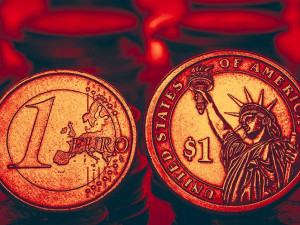
The US Dollar is the most traded currency in the world, accounting for a large percentage of daily currency trade volumes. EUR/USD is the most traded currency pair in the world, largely due to the size of the US and EU economies, but also because the USD is the primary commodity currency. As a result, EUR/USD is watched closely for any signs of volatility which may affect international trading costs.
Historically, Sterling has always been stronger than the US Dollar, but with the increasing attention that has been paid to the British economic woes, we have seen GBP/USD moving towards parity.
In this article, we’ve gathered data from a number of banks, where they have provided their currency forecasts over the past six months [1]. We have compared actual market data against bank predictions to illustrate the disparity between the two, and we have provided a reminder of significant events that may have affected currency value over the period.

EUR/USD reached parity
The exchange rate between the Euro and US Dollar reached parity for the first time in 20 years, largely owing to the Russia-Ukraine conflict, rising global inflation, a lack of investor confidence in the Euro and higher dollar yields, once the Fed started increasing US interest rates while the ECB kept rates unchanged. Uncertainty over the economic and political outlook has also driven funds towards the ‘safe haven’ USD.
Russian manufactured energy crisis crippled the EU economy
There seems little the ECB can do to remedy the situation in the short-term. The primary factors which drive the EUR lower are out of its control: Russia’s closure of the Nord Stream 1 pipeline in reaction to EU sanctions has crippled EU energy reserves and rising energy prices has added to supply-side inflation. Meanwhile, the US is more or less immune to the energy crisis, given its large fuel reserves and their position as a net exporter of oil and gas.
The situation is further compounded by the Fed’s aggressive commitment to increase interest rates to combat inflation. As they do so, global investors continue to seek the higher yields and the relative safety of USD-denominated holdings, which diverts demand away from the EUR.
US economy remained stable despite inflation
An interesting development evolved in the US economy through Q2 and Q3. Despite two consecutive quarters of negative growth, the Federal Reserve insisted the US was not in a recession.
This statement, or redefinition of ‘recession’ was supported by strong employment data: Total non-farm payroll employment increased by 263,000 in September, while the unemployment rate fell to just 3.5%.
Some economists still hope that the Fed could engineer a ‘soft landing,’ slowing the economy just enough to bring inflation back to manageable levels without causing a recession, but the wider market expects a US recession in Q1 and Q2 of 2023.
EU inflation reached a record high
The US economic outlook was not mirrored in the EU. Vice-President of the ECB, Luis de Guindos, stated he was not confident that enough had been done to control inflation. As of September 2022, inflation in the EU reached a new record high of 10% as energy prices continued to soar.
Similarly, German inflation reached a 70-year high. Top economists warned that the German economy could shrink by 7.9% in 2023 especially if an unusually cold winter demands the need for gas rationing in industry.
EUR hampered by dovish outlook
The Euro briefly climbed above parity towards the end of October as the ECB raised rates by the expected 75 basis points.
However, the market was not impressed when Lagarde announced that rate hikes would continue but refused to be drawn to comment on the possible size of future increases. Investors took this to mean that the ECB would reduce any subsequent rise to 0.5 percentage points. Lagarde’s dovish outlook caused government borrowing costs to fall sharply, and the EUR fell below parity once again.
EUR/USD Market predictions vs Reality
- In May, bank forecasts put EUR/USD at 1.1100 the following month. It actually closed out Q2 at 1.0478, which is 5.94% lower than the common bank forecast.
- The disparity between expectations and reality was even worse at the end of Q3. Bank forecasts for August of 1.0500 were 7.12% away from the reality of 0.9802.
- It is also interesting to note that, back in April, no bank predicted EUR/USD would reach parity this summer.
Press ‘play’ to watch the actual exchange rates alongside bank forecasts.
GBP/USD got close to parity
Sterling has exhibited extreme volatility, threatening to drop to parity with the USD. Years of unprecedented economic turmoil have crippled the Pound. Meanwhile, rising inflation and political chaos has hampered the recovery of the UK economy in the wake of the Pandemic.
UK government greenlit Phase 1 of North Sea exploration
The 2008 economic crisis prompted policymakers to move away from a dependence on North Sea oil and into sustainable energy. The government hastily reversed this decision as the UK scrambled for any available energy source to reduce the effect energy costs are having on the current cost of living crisis. North Sea oil reserves have been re-opened to private investors but perhaps too late to stave off recession.
Lizz Truss assumed office and appointed Kwasi Kwarteng as Chancellor of the Exchequer
In September, radical changes made by newly elected PM Liz Truss caused turmoil in the British economy. Less than a month into her tenure, her political authority has rapidly eroded as her bold plans have been met with widespread criticism both from within her party and outside.
Together with Kwasi Kwarteng, as her Chancellor, they delivered an extensive package of tax measures less than three weeks into the PMs term. Their mini-budget immediately drew concern from the market and it appeared to have been put together without consultation with Treasury civil servants, the Bank of England or the OBR.
Investor confidence dropped like a stone and Sterling fell sharply against the USD.
Kwarteng made U-turn and was replaced with Jeremy Hunt
In an unprecedented move, the IMF stated that Kwarteng’s top-tier tax cuts would only create greater economic disparity and do little to solve the UK’s economic woes.
Faced with a party revolt, Kwarteng and Truss were forced to scrap most planned cuts. Shortly after, Truss sacked Kwarteng from his role as Chancellor, replacing him with Jeremy Hunt.
Hunt reversed almost all tax measures set out in the mini-budget, and the Pound rose against the Dollar, but this wasn’t enough to save Truss.
Truss resigned and was replaced by Rishi Sunak
Liz Truss resigned as UK Prime Minister on the 20th of October, ending a fairly disastrous period for the UK economy.
Rishi Sunak gained the necessary support to take over at Number 10 and was quickly confronted with the daunting task of undoing some of the damage inflicted on the UK economy by Truss’s questionable decisions.
Jeremy Hunt retained his post as Chancellor of the Exchequer and he reversed the £32 billion in tax cuts that formed the bedrock of Truss’ economic plans, but there is still a £30 billion hole in the UK’s balance sheet.
The markets reacted well to Sunak’s election but the Pound’s value remained relatively unchanged overall.
GBP/USD Market predictions vs Reality
- In May, banks forecasted GBP/USD exchange rate to end Q2 at 1.3100. Instead it closed out at 1.2160, which is 7.73% lower than forecasts.
- The disparity between forecasts and reality was even worse at the end of Q3. Bank predictions of 1.2200 ended up 9.24% away from the market rate of 1.1168.
- Back in April, no banks predicted the Sterling would get so close to parity with the USD.
Press ‘play’ to watch the actual exchange rates alongside bank forecasts.
GBP/EUR still disrupted by Brexit
The EUR and GBP have long exhibited strong co-movement in financial markets. The economic effects of Brexit have been more evident to British businesses than those of Europe.
Germany broke with the ECB
Trouble between the EU and its constituent members has been long-brewing, Christine Lagarde permitted the ECB to enter financial markets and buy bonds directly, hoping to ensure that Eurozone markets retained sufficient financial liquidity.
The German Constitutional Court (GCC) doubted the legality of the purchases under German law. Later, an amendment to the nation’s banking act permitted the German Finance Ministry to override EU directives concerning financial risk management and internal banking decisions.
When the ECB resumed its bond-buying scheme in light of the pandemic, German courts threatened to block the central bank’s purchases of German bonds, which caused the EUR to devalue sharply by 1.4%.
In September 2022, German Chancellor Olaf Scholz set out a €200 billion support package intended to halt rising gas prices and protect households from the impact of soaring energy prices. In comparison, the UK pledged only £60 million. The measures directly challenge ECB fight against inflation, hampering the Banks’ ability to keep the rates down as inflation continues to rise.
Further Brexit changes have been discussed
The Trade and Cooperation Agreement (TCA) was drafted to help reintroduce a frictionless trade environment between the UK and EU. Both parties agreed to zero tariff and zero quota trade on goods. Despite easing restrictions, trade between the UK and EU fell. UK imports from the EU dropped 18% on 2019 levels, while export to the EU dropped 9%.
In 2021, UK businesses importing from the EU had the option to delay submitting a customs declaration to HMRC for up to 6 months. However, as of 1 January 2022, full customs entries were made mandatory before goods were brought into the country.
The Federation of Small Businesses reported that at the time, only 25% of small British importers were ready for this update to take effect. Many vendors in the EU decided to suspend their supply of goods to UK customers, while many UK SMEs were forced to redirect their goods to the domestic market.
New amendments further disrupted trade in July 2022 with laws pertaining to perishable goods. It’s likely more changes are to come in the near future.
GBP/EUR Market predictions vs Reality
- In May, banks forecast GBP/EUR to end Q2 at 1.1900. The market closed at 1.1606, which is 2.53% lower than forecasts.
- Bank predictions in August of 1.1600 ended up 1.81% higher than the market rate of 1.1394.
- The wide range between rates forecasted shows the inaccurate nature of currency forecasts.
Press ‘play’ to watch the actual exchange rates alongside bank forecasts.
History shows you can’t predict the future
In a perfect world, investors, business owners and policymakers would have full confidence in government published economic reports and banking forecasts. Numbers, charts and graphs are a nice, neat way of distilling the complexity of modern day economics and finance into clear actionable data.
Business owners could make more informed decisions and those who rely on future forecasts would outshine any ‘crystal ball’ methods to divine the future.
Unfortunately, that’s simply not the case. The disparity between bank predictions and actual rates shows that decisions cannot accurately be based on currency forecasts alone. Furthermore, the inherent inaccuracy of these predictions, linked in part to the speculative nature of so many market participants, makes it vital to be more proactive about currency risk management.
Safely navigating currency markets, especially in uncertain times, is a challenging prospect, but you don’t have to do it alone. If you want help, guidance, or just a second opinion for additional peace of mind, our FX specialists at CurrencyTransfer can help you find the best course of action, for your business and your specific exposures, to ensure you remain profitable and secure, no matter what the future holds.
[1] Source: Bloomberg.
Matthew Swaile
Copywriter
Florence Couëdel
Editor
Paul Plewman
Editor




